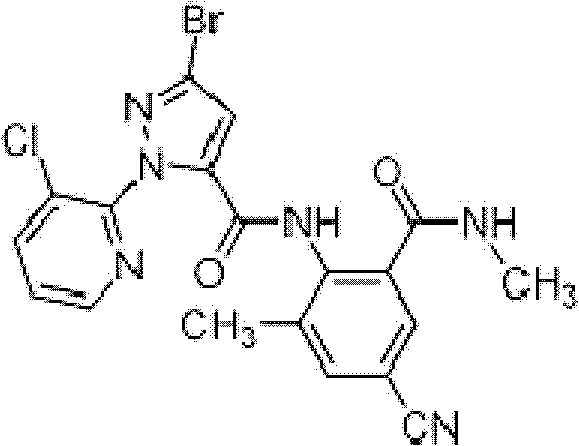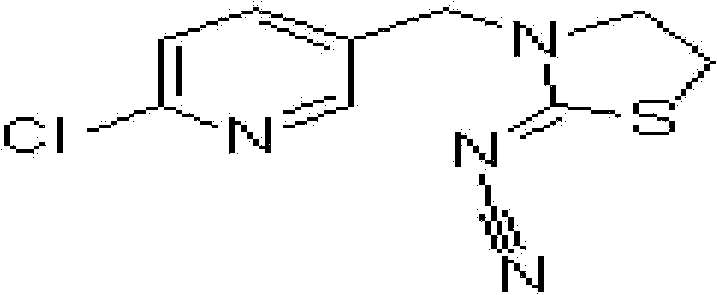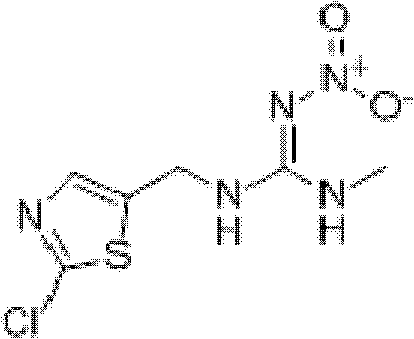Insecticidal composite containing Cyantraniliprole and anabasine compounds
An insecticidal composition, the technology of cyantraniliprole, which is applied in the field of pesticide compounding, can solve the problems of undisclosed compounding and achieve the effects of reasonable components, less preparation residue, and more pest action sites
- Summary
- Abstract
- Description
- Claims
- Application Information
AI Technical Summary
Problems solved by technology
Method used
Image
Examples
example 1
[0057] Diamondback moth (Plutella xylostella) Lepidoptera Xylostella family, alias: small caterpillar, two pointed. It is a worldwide migratory pest and mainly damages Brassicaceae plants such as cabbage, purple cabbage, broccoli, mustard greens, cauliflower, cabbage, rape, and radish. Damage characteristics: the first instar larvae only feed on the mesophyll, leaving the epidermis, forming transparent spots on the vegetable leaves, "opening the skylight", the 3rd to 4th instar larvae can eat the vegetable leaves into holes and nicks, and in severe cases, the whole leaf is covered Eat into a net. In the seedling stage, the center leaves are often damaged, affecting the heart of the package. On seed-retaining plants, the young stems, young pods and grains are harmed.
[0058] The test method refers to the "People's Republic of China Agricultural Industry Standard NY / T1154.7-2006". The test insects are the pupae of diamondback moth collected from the field, and the radish seed...
example 2
[0069] The rice leaf roller (Cnaphalocrocis medinalis Guenee) belongs to Lepidoptera, Mothidae, and is a migratory flying pest. The larvae feed on the leaves of rice and cause damage. The newly hatched larvae feed on the heart leaves, and small needle-like spots appear, and some damage first in the leaf sheath. Cylindrical buds in which the larvae hide and eat the mesophyll, leaving white streaks on the skin. When it is serious, "the buds of insects are numerous, and the field is full of white leaves". The losses are the greatest at the pregnancy and heading stages.
[0070] Rice leaf roller: The test method refers to the "People's Republic of China Agricultural Industry Standard NY / T1154.7-2006", the test insects are adult rice leaf rollers collected from the field, and the rice seedlings are used to raise indoors, and the first generation hatching is adopted of larvae. Select larvae with uniform growth and insert them into a petri dish with a diameter of 12 cm in which fr...
example 3
[0077] Rice stem borer (Chilo suppressalis), commonly known as core borer, borer, etc., belongs to Lepidoptera and Borididae. It is one of the most serious frequent pests on rice in my country. The heart seedlings are damaged at the ear stage and cause insect damage to the plants and white ears. In general, the yield is reduced by 3% to 5%, and in severe cases, the yield is reduced by more than 30%. It is distributed in all rice areas in China, but it mainly occurs in the Yangtze River Basin and the southern rice areas, and the number of occurrences has shown a significant increase in recent years. In addition to harming rice, Chilo borer can also harm weeds such as water bamboo, corn, sorghum, sugar cane, rape, broad bean, wheat, reed, barnyardgrass, and Lishihe.
[0078] The indoor bioassay method is as follows: the capillary micro-drop method is adopted, and the volume of the capillary micro-dropper is 1.0 μL. Use a micro-dropper to drop the medicinal solution head by head ...
PUM
 Login to View More
Login to View More Abstract
Description
Claims
Application Information
 Login to View More
Login to View More - R&D
- Intellectual Property
- Life Sciences
- Materials
- Tech Scout
- Unparalleled Data Quality
- Higher Quality Content
- 60% Fewer Hallucinations
Browse by: Latest US Patents, China's latest patents, Technical Efficacy Thesaurus, Application Domain, Technology Topic, Popular Technical Reports.
© 2025 PatSnap. All rights reserved.Legal|Privacy policy|Modern Slavery Act Transparency Statement|Sitemap|About US| Contact US: help@patsnap.com



